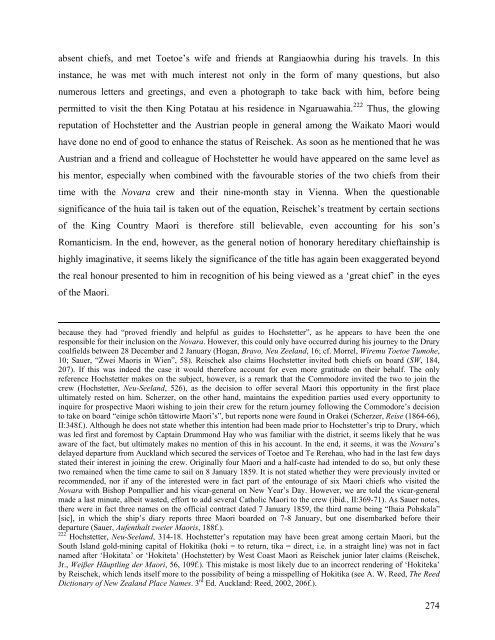General copyright and disclaimer - ResearchSpace@Auckland ...
General copyright and disclaimer - ResearchSpace@Auckland ...
General copyright and disclaimer - ResearchSpace@Auckland ...
You also want an ePaper? Increase the reach of your titles
YUMPU automatically turns print PDFs into web optimized ePapers that Google loves.
absent chiefs, <strong>and</strong> met Toetoe’s wife <strong>and</strong> friends at Rangiaowhia during his travels. In this<br />
instance, he was met with much interest not only in the form of many questions, but also<br />
numerous letters <strong>and</strong> greetings, <strong>and</strong> even a photograph to take back with him, before being<br />
permitted to visit the then King Potatau at his residence in Ngaruawahia. 222 Thus, the glowing<br />
reputation of Hochstetter <strong>and</strong> the Austrian people in general among the Waikato Maori would<br />
have done no end of good to enhance the status of Reischek. As soon as he mentioned that he was<br />
Austrian <strong>and</strong> a friend <strong>and</strong> colleague of Hochstetter he would have appeared on the same level as<br />
his mentor, especially when combined with the favourable stories of the two chiefs from their<br />
time with the Novara crew <strong>and</strong> their nine-month stay in Vienna. When the questionable<br />
significance of the huia tail is taken out of the equation, Reischek’s treatment by certain sections<br />
of the King Country Maori is therefore still believable, even accounting for his son’s<br />
Romanticism. In the end, however, as the general notion of honorary hereditary chieftainship is<br />
highly imaginative, it seems likely the significance of the title has again been exaggerated beyond<br />
the real honour presented to him in recognition of his being viewed as a ‘great chief’ in the eyes<br />
of the Maori.<br />
because they had “proved friendly <strong>and</strong> helpful as guides to Hochstetter”, as he appears to have been the one<br />
responsible for their inclusion on the Novara. However, this could only have occurred during his journey to the Drury<br />
coalfields between 28 December <strong>and</strong> 2 January (Hogan, Bravo, Neu Zeel<strong>and</strong>, 16; cf. Morrel, Wiremu Toetoe Tumohe,<br />
10; Sauer, “Zwei Maoris in Wien”, 58). Reischek also claims Hochstetter invited both chiefs on board (SW, 184,<br />
207). If this was indeed the case it would therefore account for even more gratitude on their behalf. The only<br />
reference Hochstetter makes on the subject, however, is a remark that the Commodore invited the two to join the<br />
crew (Hochstetter, Neu-Seel<strong>and</strong>, 526), as the decision to offer several Maori this opportunity in the first place<br />
ultimately rested on him. Scherzer, on the other h<strong>and</strong>, maintains the expedition parties used every opportunity to<br />
inquire for prospective Maori wishing to join their crew for the return journey following the Commodore’s decision<br />
to take on board “einige schön tättowirte Maori’s”, but reports none were found in Orakei (Scherzer, Reise (1864-66),<br />
II:348f.). Although he does not state whether this intention had been made prior to Hochstetter’s trip to Drury, which<br />
was led first <strong>and</strong> foremost by Captain Drummond Hay who was familiar with the district, it seems likely that he was<br />
aware of the fact, but ultimately makes no mention of this in his account. In the end, it seems, it was the Novara’s<br />
delayed departure from Auckl<strong>and</strong> which secured the services of Toetoe <strong>and</strong> Te Rerehau, who had in the last few days<br />
stated their interest in joining the crew. Originally four Maori <strong>and</strong> a half-caste had intended to do so, but only these<br />
two remained when the time came to sail on 8 January 1859. It is not stated whether they were previously invited or<br />
recommended, nor if any of the interested were in fact part of the entourage of six Maori chiefs who visited the<br />
Novara with Bishop Pompallier <strong>and</strong> his vicar-general on New Year’s Day. However, we are told the vicar-general<br />
made a last minute, albeit wasted, effort to add several Catholic Maori to the crew (ibid., II:369-71). As Sauer notes,<br />
there were in fact three names on the official contract dated 7 January 1859, the third name being “Ihaia Pohskala”<br />
[sic], in which the ship’s diary reports three Maori boarded on 7-8 January, but one disembarked before their<br />
departure (Sauer, Aufenthalt zweier Maoris, 188f.).<br />
222 Hochstetter, Neu-Seel<strong>and</strong>, 314-18. Hochstetter’s reputation may have been great among certain Maori, but the<br />
South Isl<strong>and</strong> gold-mining capital of Hokitika (hoki = to return, tika = direct, i.e. in a straight line) was not in fact<br />
named after ‘Hokitata’ or ‘Hokiteta’ (Hochstetter) by West Coast Maori as Reischek junior later claims (Reischek,<br />
Jr., Weißer Häuptling der Maori, 56, 109f.). This mistake is most likely due to an incorrect rendering of ‘Hokiteka’<br />
by Reischek, which lends itself more to the possibility of being a misspelling of Hokitika (see A. W. Reed, The Reed<br />
Dictionary of New Zeal<strong>and</strong> Place Names. 3 rd Ed. Auckl<strong>and</strong>: Reed, 2002, 206f.).<br />
274















